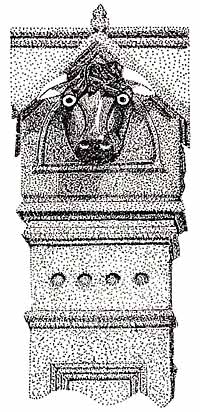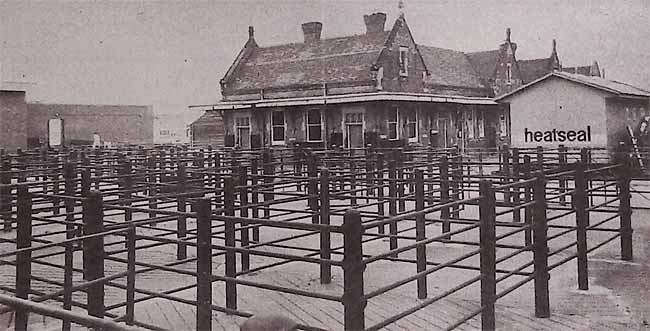< Previous
SNEINTON'S OTHER MARKET:
The story of the Cattle Market
By Stephen Best
'THE OFFSPRING OF HIS BRAIN'
 Detail of a Cattle Market gatepost by Bill Vincent
Detail of a Cattle Market gatepost by Bill VincentThis ringing phrase was uttered by Alderman Acton, Chairman of the Markets Committee of Nottingham Corporation. The date was September 28th, 1886, the brain belonged to Mr. Arthur Brown, Borough Engineer and its offspring was the New Cattle Market on Meadow Lane.
The earlier history of the market must briefly be told. For centuries animals were sold on the south side of the Great Market Place. A wall, first mentioned in the sixteenth century, ran east to west across the Market Place and up Chapel Bar. Historians formerly believed that it was erected in order to separate the fractious inhabitants of the French and English Boroughs but as the whole of the Market Place lay in the French Borough this theory may safely be set aside. It is possible that the wall, which remained in a dilapidated condition until the 1720's, divided the northern part of the market, in which food and other goods were sold, from the southern portion, where horses, cattle and other livestock were dealt with. By the beginning of the nineteenth century, stallholders in the market and residents of Beastmarket Hill, where sheep and cattle pens were put up twice weekly, were loud in their complaints against the livestock which wandered about the town centre. In 1811 a curbed causeway with chains and posts was put down to stop the encroachment of animals and its attendant nuisance. (Indeed one speaker in 1886 was to recall that the words 'a bull in a china shop' had been far more than a mere figure of speech in Nottingham.) During the 1820's the Saturday cattle market was re-sited at the junction of Parliament Street and Wollaton Street. As may be imagined, this move was not entirely successful in doing away with the inevitable public inconvenience and in 1853 the objecting faction managed to get the cattle fairs previously held in the Market Place and the Town Fields moved to a location in Burton Street, close to Sherwood Street. Agitation to banish all livestock from the Market Place continued unabated and in 1870 a chosen site was established on Burton Leys, where the Guildhall now stands, and livestock markets left the Market Place for ever.
As the Guildhall opened in 1888, it will be obvious that the Cattle Market's stay on Burton Leys was not a long one. In 1884 Mr. Brown visited markets at such diverse places as York, Islington, Northampton, Deptford, Leicester, King's Lynn, Melton Mowbray and Crewe to gain information which would help him in designing a new market. The place chosen for this undertaking was at the south east corner of the East Croft, bounded on the east by the recently opened Midland Railway line to London via Melton Mowbray, and on the south by Meadow Lane. It was designed to be as far away as possible on this site from the East Croft Sanitary Depot which lay beside the canal and was reached from London Road over a bridge opposite Queen's Road.

Following his travels Arthur Brown submitted plans for a new model market. These were unanimously passed by the Markets Committee and later confirmed by the Town Council. Mr. Brown estimated that the cost of the scheme would be between £27,500 and £29,500. Work began in June 1885, though ground levelling and filling had already been in progress for some time. The area was raised six or seven feet, a task which involved some 50,000 square yards of land and used 100,000 cubic yards of soil.
Two main entrances to the Market were made - from Meadow Lane to serve Sneinton and the southern and eastern traffic, and from London Road via a new bridge opposite Kirke White Street to accommodate traffic from the north and west. The approach road from London Road was divided into 'in' and 'out' lanes by an iron fence, an innovation which was to obviate much of the congestion which had beset the previous market. Of particular importance were the cattle sidings laid down to connect with the Midland Railway. These were within the precincts of the Market itself, while cattle docks were also installed on the Great Northern Railway by the overbridge at the Sneinton end of Meadow Lane. Accustomed as we are today to efficient transport of cattle by road, we may find it hard to realise with what relief the citizens of Nottingham greeted any falling off in the number of cattle being driven through their streets.
The Nottingham Daily Express, in describing the new work, observed that 'the requirements of those attending the Market have been very carefully considered and every facility will be given to buyers and sellers to conduct their business easily and quickly and with more than an ordinary degree of comfort'. To this end two blocks of buildings were erected. One consisted of offices for the market inspectors, auctioneers and other officials, with telegraph offices and banking agencies. This building also contained lavatories and washrooms.
The second block housed two refreshment rooms, a dining room and kitchens. All round the two blocks was a verandah about six feet wide to shelter market users in wet weather.
The press continued in its description of the Market by noting the hay and straw market and the one acre Horse Fair Field. Accommodation for the animals was also discussed, including cattle stalls for 700 beasts. These were constructed in a way that allowed beasts in opposite stalls to be further apart from each other than had previously been the case. Other facilities included pens for the auctioning of 400 beasts, sheep pens with a capacity of 2,500 and a pig and cattle shed for 450 pigs and calves. Lairs for night storage of fat stock (best kept under cover) were installed. The Committee emphasised that the accommodation provided was generous but that they were looking to the future. It was hoped that use of the Market would increase and that the excellence of its facilities might lure trade away from other markets in the East Midlands. Near the entrance was a slaughterhouse in which 'any beast must be slaughtered at once which shows any sign of madness'. This limited provision, and the absence of a central abattoir for humane slaughtering, met with considerable criticism, as it meant that private butchering of beasts would continue.
The Cattle Market buildings were of brick, with Hollington stone dressings, and the work was judged as being 'of the best possible description'. It was declared by the Markets Committee that no money had been wasted on architectural display, as costs had been kept as low as possible. One of the great features of the Market was that it was paved throughout with concrete, grooved to give a foothold for the cattle, which made a perfectly impervious pavement, easily washed and kept clean. Patent flushing syphons were provided for cleaning out the drains, and with these, and the paving, which were both hailed as highly desirable innovations, it was perhaps not surprising that Mr. Brown's estimate was exceeded. In fact the bill for the New Cattle Market amounted to some £32,000, plus the cost of land and filling of the site.
The formal opening, on September 28th, 1886, was accorded a degree of publicity scarcely credible in 1981. Houses in the neighbourhood were decorated with flags, streamers and coloured bunting to an extent which the press gently chided as 'rather lavish'. Before a large and eager assembly the Mayor, Alderman Lambert, arrived to perform the opening ceremony,but the proceedings were held up by the delayed arrival of Earl Manvers, whose train was late.
(The Earl was a principal landowner of Sneinton, in which parish the Cattle Market chiefly lay, in contradistinction to Sneinton Market, which never was in the parish.) Alderman Acton then made his speech characterising the Market as the offspring of Mr. Brown's brain, and expressing his pleasure that the New Cattle Market had been designed by a Borough official. The Mayor, in his address, declared that 'the place, in which for many years cattle was sold in Nottingham, was a crying evil and, he might say, a disgrace to the Town'. This observation was greeted with cries of 'hear, hear' and Mr. Lambert warming to his theme, went on to say that 'it was impossible for timid ladies or children to walk about the streets on market day without being in constant fear of their lives'. He closed by observing that it was as a result of Mr. Brown's planning that Nottingham had such a splendid market, a popular sentiment that provoked loud applause. The company then inspected the Market and the first auction took place, in which a white cow belonging to the Mayor was knocked down to a Mr. Curtis Maclin for £22.5s. The official party then adjourned to the Exchange, which was decorated with exotic plants for the day, and sat down to a celebratory dinner, described as 'a most recherché one'. The Mayor apologised for the hurried nature of the proceedings but explained that Earl Manvers had to leave early. The Earl seems to have had little real enthusiasm for the day, for not content with arriving late and leaving early, he made a speech which boiled down to the view that, while he wished he could think that the New Cattle Market heralded better times for the agricultural community, he was sure that it did not and that there were bad times ahead for everyone. He did, however, remark that they had been lucky with the weather. Mr. George Storer of the Notts. Chamber of Commerce then declaimed on the evils of free trade and Alderman Lambert asserted that the authorities would not be satisfied until a central abattoir, was established in the Cattle Market, thus ending the brutal slaughter of beasts in private slaughterhouses scattered throughout Nottingham. All praised Mr. Brown and the modest hero of the hour replied that he 'had used his best endeavours to do some work in connection with the Market' and hoped that it would reflect some small amount of credit on himself.
Some idea of how eagerly the New Market was awaited can be gained from the fact that, in addition to detailed descriptions of the site and verbatim reports of the formal opening and consequent junketings, the local press marked the event with leading articles. The Nottingham Daily Express editorial stated that the whole town could join in the congratulations, and expressed pleasure that the people of Nottingham would be spared the experience of having droves of bullocks passing through their midst in crowded streets. The proximity of the railways to the Market would, it felt, greatly lessen this evil. The leader writer added his disapproval of the absence of a public abattoir, and took Earl Manvers and Mr. Storer to task for their comments at the dinner.
So the Cattle Market became an accepted part of the Nottingham scene and the innovations hailed with such pride in 1886 came to be regarded as commonplace. In the intervening ninety-five years many changes have occurred. The Market got its abattoir, though it had to wait for it until 1938, and in 1962 acquired a cold store. It has become a noted place to buy tools but the railway link, so newly forged in the 1880's has gone. When all is said and done, however, the core of the Cattle Market we know today is still the brainchild of Mr. Arthur Brown.
STEPHEN BEST
Stephen Best grew up in Sneinton and maintains a keen interest in the area. He is a Local Studies librarian and will be known to listeners of Radio Nottingham for his talks on the history of the locality.
< Previous
